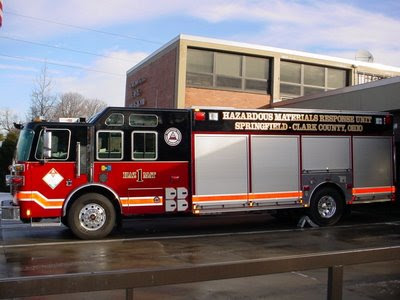 Crowell-Collier General Alarm - 1999
Crowell-Collier General Alarm - 1999 Springfield, seat of Clark County, Ohio, is located between Dayton (to the west) and Columbus (to the east).
Springfield, seat of Clark County, Ohio, is located between Dayton (to the west) and Columbus (to the east).
The Springfield Fire Rescue Division is a career fire department that protects the City of Springfield, Ohio, which is located along Interstate 70 and the old ``National Road'' in West Central Ohio. The city is the seat of Clark County.
The fire and rescue service - responsible for emergency medical care, firefighting, technical rescue and hazardous materials response - fields 10 companies operating from seven stations in three platoons (or shifts).
The shifts (A Unit, B Unit and C Unit) work ``24 hours on, 48 hours off.'' Each platoon is commanded by a battalion chief - a rank previously called "platoon commander" or "platoon chief."
Crews of the city's ``combination companies'' respond with either an engine or medic unit depending on the nature of the call - fire, medical, etc. The city also operates a rescue engine, three aerial ladders, a Hazmat unit and a technical rescue unit. An engine and medic unit are also held in reserve.
Typical on-duty staffing is three firefighters per vehicle - or about 30 firefighters, paramedics and officers - per shift. Combination companies are led by lieutenants. The rescue is also led by a lieutenant. Truck companies (the aerial ladders) are led by captains.
The fire rescue division is commanded by the Fire Chief, who is supported by two assistant chiefs and a headquarters staff of uniformed and civilian personnel.
The volunteers of the Box 27 Associates club assist the fire division at major fires and emergencies. The volunteers operate a light and air wagon and a mobile canteen.
Township fire departments protect the rest of Clark County and provide mutual aid to the city, and the Ohio Air National Guard operates a fire and rescue station at the municipal airport.
Finances
The story of the Springfield Fire Rescue Division is one of dedicated service and innovation against a backdrop of difficult municipal finances and chronic personnel shortages.
Station No. 2 closed during the Great Depression, and Station No. 9 closed in 1974 as the city's manufacturing base started to shrink.
In the early 1990s, three of the city's fire stations had only two firefighters assigned to each shift, and by mid-decade, the engine company at Station No. 1 was disbanded.
On average, the city's fire engines carried larger crews before the Great Depression of the 1930s, though at that time firefighters also worked longer hours.
The situation has since been reversed. A new policy of billing for ambulance services is providing more money for the recruitment of firefighters and paramedics.
Roberds Book
The fire division was the subject of the 1978 book ``From Buckets to Diesels'' by Springfield Fire Captain Calvin Roberds, who began his career as an auxiliary fireman during World War II. He retired in 1985, having attained the rank of platoon commander.
Roberds, who took great pride in his work as a fire service historian, died in 1995 at the age of 72.
The firefighters' union (IAFF Local 333) and Box 27 Associates helped raise funds for the publication of Roberds' book.
The Springfield Fire Journal is intended to serve as a 21st Century extension of Captain Roberds' comprehensive work. Besides adding new features to the Fire Journal, your editor regularly updates existing articles.
Suggestions are welcomed at wb2kqg@arrl.net
City Heritage
Springfield, established in 1799 by James Demint and migrant Kentuckians, evolved into a major industrial center in the 19th and 20th centuries.
In the 1800s, it led the U.S. in production of agricultural equipment. In the early 1900s, the city's factories produced a variety of autos, including the Bramwell, Brenning, Foos, Frayer-Miller, Kelly Steam, Russell-Springfield and Westcott, according to the Ohio Historical Society.
As the community evolved, fire protection evolved too - from bucket brigades, to volunteer companies and minute men, to a paid fire department to today's fire-rescue service.
Prevention vs Suppression
In the fire service, community safety is Priority No .1.
In his book, Roberds observed:
``Considering the primary mission of the fire service - fire prevention - the fire division has done its most effective work when the engines are in the engine houses. Yet the average citizen is apt to feel that engines not in use are not needed. Conversely, when the firefighters and engines are hard at work on a major fire, the first mission of the fire service has already been lost.''
Paramedics
Since the fire division fielded its first "Emergency Squad" in 1949, its role as first responder to medical emergencies has increased, with medical runs accounting for more than 80 percent of ALL the division's annual runs.
The formal name of the agency was changed to the Springfield Fire Rescue Division in the 1990s to reflect its wider role in the community.
In the annual report for 2004, Springfield Fire Chief Mike Beers reported that three decades after the establishment of the paramedic program - during the tenure of Fire Chief Frank Trempe - more than 80 percent of the city's firefighters are certified to provide advanced life support.
``Frank Trempe was my first fire chief, and he is oftentimes credited with having the vision to embrace the paramedic program that has led to our having the ability today to provide emergency medical services second to none,'' Beers wrote.
































